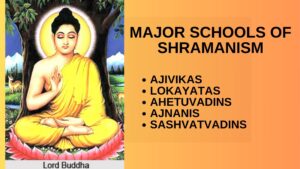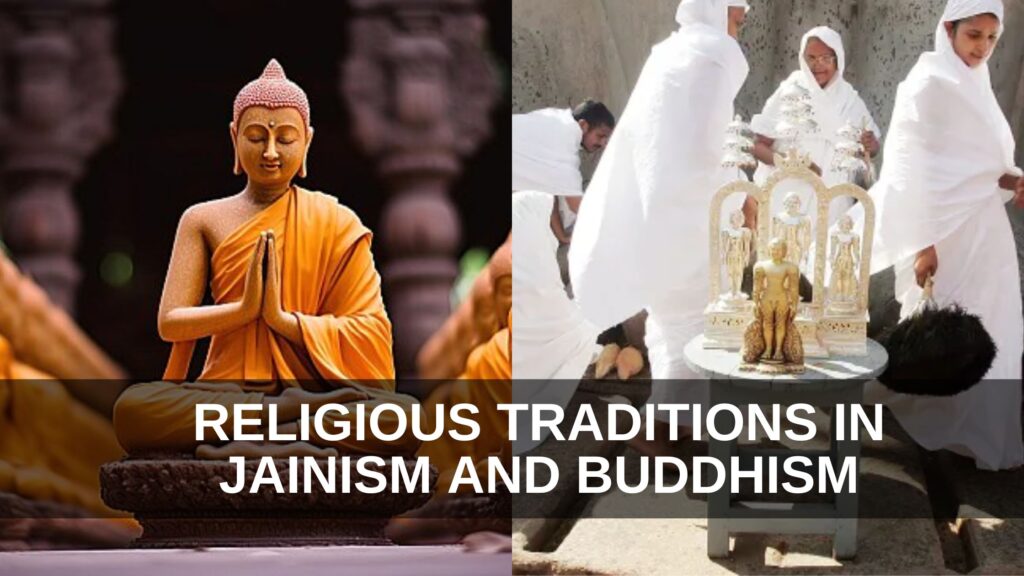The post-Vedic period in India witnessed a major transformation in religious practices, leading to the emergence of new religious movements such as Jainism and Buddhism. These movements significantly influenced Indian society, polity, and administration for centuries.
At the heart of this transformation was the Shramana tradition, a counter-movement against the increasingly ritualistic and complex Vedic religion.
The Shramana Tradition: A Quest for Truth
The term ‘Shramana’ signifies striving and rigorous effort, particularly through asceticism, in pursuit of ultimate truth. The Shramanas were individuals who renounced worldly life and sought enlightenment through meditation and austerity in the forests.
This movement led to the rise of various religious schools, including Buddhism, Jainism, Lokayata, and Ajivika, all of which questioned the authority of the Vedas and challenged Brahmanical dominance.
Read About… Harappan Civilization
Causes for the Emergence of the Shramana Movement
- Varna System and Social Tensions: The Brahmanas held the highest status in post-Vedic society, leading to resentment among the Kshatriyas. Vardhamana Mahavira and Gautama Buddha, both from the Kshatriya clan, opposed Brahmanical hegemony.
- Cumbersome and Expensive Rituals: The elaborate nature of Vedic rituals made religious practices inaccessible to common people, prompting many to seek simpler alternatives.
- Agricultural Advancements: The use of iron-tipped ploughshares and bullocks for farming conflicted with Vedic practices of animal sacrifices, making non-violent religions more appealing.
- Economic Growth of the Vaishyas: The rise of trade and commerce empowered the Vaishya class, who were drawn to non-violent and inclusive religions like Jainism and Buddhism.
- Reaction Against Material Culture: The increasing materialism of society created disparities, leading many to embrace the simplicity of Buddhism and Jainism.
Major Schools of Shramanism

1. Ajivikas (The Fatalists)
- Believed in the doctrine of Niyati (fatalism), asserting that fate determines all events.
- Founded by Makkhali Goshala, a contemporary of Buddha and Mahavira.
- Flourished under Emperor Bindusara and had rock-cut cave dwellings in the Mauryan period.
2. Lokayatas (Materialists/Atheists)
- Advocated materialism, rejecting afterlife concepts.
- Associated with the Charvaka school, which promoted pleasure as the ultimate goal of life.
- Ajita Kesakambali was a key proponent of this school.
3. Ahetuvadins (Amoralists)
- Denied the consequences of actions, rejecting the theory of Karma.
- Led by Purana Kassapa.
4. Ajnanis (Agnostics)
- Believed that metaphysical knowledge was unattainable.
- Sanjaya Belatthiputta was a key figure.
5. Sashvatvadins (Eternalists)
- Held that the universe consisted of seven eternal elements.
- Founded by Pakudha Kaccayana.
Common Features of the Shramana Tradition
- Rejected the authority of the Vedas (Nastika philosophy).
- Opposed Brahmanical rituals and caste hierarchy.
- Emphasized non-violence, simple living, and philosophical discourse.
- Promoted doctrines like Karma, Fatalism, and Materialism.
Read this blog also.. Chalcolithic Age
Jainism: The Path of the Jinas
Jainism derives from ‘Jina,’ meaning conqueror of the self. The religion traces its origins to 24 Tirthankaras, the last two being Parsvanatha and Mahavira.
Vardhamana Mahavira (540–468 BCE)
- Born in Kundagrama, Vaishali, to a Kshatriya family.
- Attained enlightenment at the age of 42 after 12 years of asceticism.
- Rejected Vedic authority, advocated non-violence, and emphasized self-discipline.
Core Jain Teachings
- Non-theism: No belief in a creator god.
- Doctrine of Karma: Karma binds the soul to the cycle of rebirth.
- Five Vows (Panchvrata): Truth, Non-violence, Non-possession, Non-stealing, Celibacy.
- Three Jewels (Triratna): Right Faith, Right Knowledge, Right Conduct.
- Anekantavada & Syadavada: Emphasized multiple perspectives on truth.
Jain Sects: Digambara vs. Shvetambara
- Digambara: Advocated nudity, denied women’s liberation.
- Shvetambara: Allowed monks to wear white clothes and recognized women’s ability to attain liberation.
Buddhism: The Middle Path
Founded by Gautama Buddha (566–486 BCE), Buddhism emerged as a practical and ethical philosophy aimed at ending human suffering.
The Four Noble Truths
- Life is suffering (Dukkha).
- Desire causes suffering (Dukkha Samudaya).
- Suffering can end (Dukkha Nirodha).
- The Eightfold Path leads to liberation (Dukkha Nirodha-Magga).
The Noble Eightfold Path
- Right View, Right Aspirations, Right Speech, Right Conduct, Right Livelihood, Right Effort, Right Awareness, Right Concentration.
Buddhist Councils & Sects
- 1st Council (400 BCE, Rajgriha): Compilation of Sutta and Vinaya Pitakas.
- 2nd Council (300 BCE, Vaishali): Led to the Mahasamghika sect.
- 3rd Council (250 BCE, Pataliputra): Sponsored by Ashoka, formed the Abhidhamma Pitaka.
- 4th Council (1st Century CE, Kashmir): Patronized by Kanishka, led to the rise of Mahayana Buddhism.
Decline of Jainism & Buddhism
- Loss of Royal Patronage: Jainism and Buddhism initially enjoyed state support but later lost prominence to Hinduism.
- Lack of Missionary Zeal: Jainism remained restrictive, while Buddhism actively spread across Asia.
- Strict Asceticism: Jainism’s extreme austerities alienated common people.
- Buddhism’s Assimilation into Hinduism: Hinduism absorbed many Buddhist teachings and figures.
- Rise of Bhakti Movements: Devotional movements like Vaishnavism, Shaivism, and Shaktism overshadowed Jainism and Buddhism.


